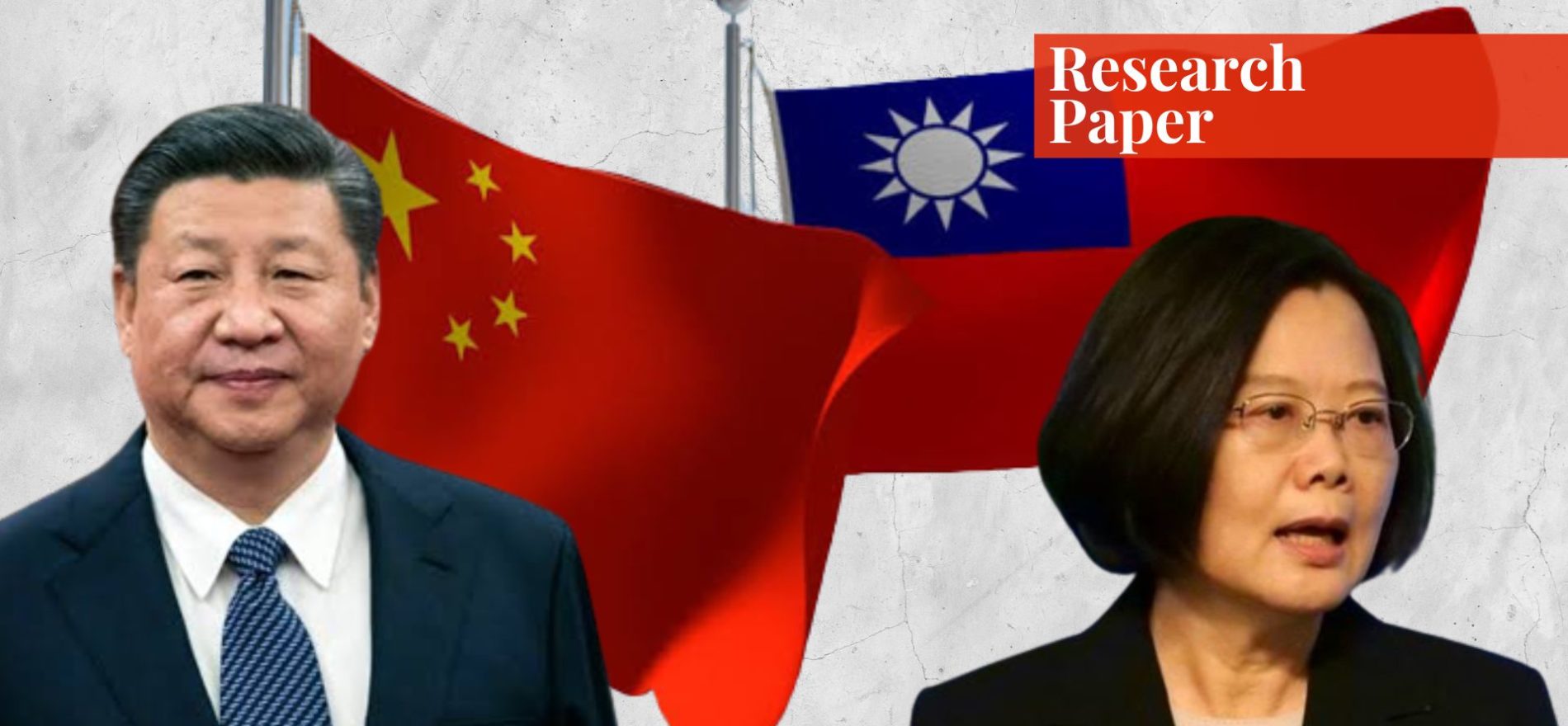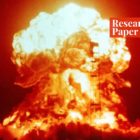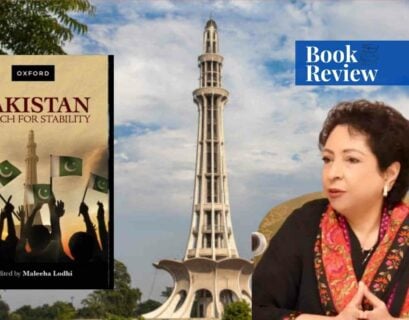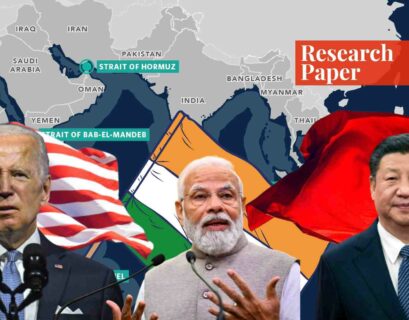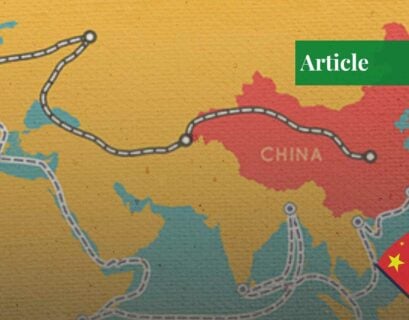Atiqa Javed is currently a student of international relations at National Defence University, Islamabad. Her areas of interest include geopolitical and geoeconomic shifts, foreign policy analysis, climate change, human rights, and diplomatic shifts among states.
Abstract
This research paper analyzes the China-Taiwan conflict through the perspective of social constructivism as the research delves into the history and sociopolitical framework of the China-Taiwan conflict. The research paper comprehends that the most vital concern in resisting Chinese unification is Taiwanese identity.
Taiwanese people are seeking a sense of national identity, as manifested in the Sinicization and Taiwanization processes. The actors shaped the perception of the locals in a way that they consider themselves Chinese and Taiwanese. However, the US played an important role in shaping the identity of the Taiwanese and fueling the conflict.
Introduction
Taiwan is a Chinese island split by the Taiwan Strait. It is formally known as the “Republic of China” (ROC). It’s been controlled independently of the mainland People’s Republic of China (PRC) since 1949. High tensions in the Taiwan Strait have been exacerbated by some Taiwanese seeking independence, while communist China insists on uniting Taiwan and curbing Taiwan’s separatist effort.
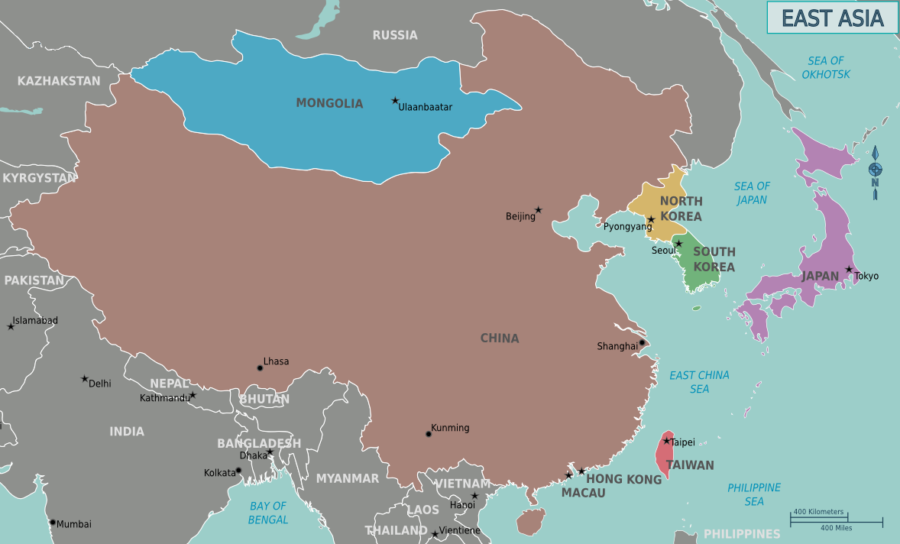
This paper’s major objective is to investigate the cross-strait conflict. Hence, the research identifies two political trends in Taiwan that shape national identity – namely, Sinicization and Taiwanization.1 Taiwan’s future growth is critically dependent on these two factors and the conflict between them.
Theoretical Framework
China-Taiwan conflict is explained through social constructivism which holds the collective consciousness and is the perception of the distinction between “we” (in-group) and “them” (out-group). They accept other people’s “they” as “us” in the community. A nation is constituted by people’s subjective interpretation of reality. If people of the same culture, ethnicity, and religion live in two distant places, a diverging pool of knowledge will form over time. It leads to in-group and out-group differentiation, which will be a cause of conflict.2 When disparities in knowledge are faced, they result in conflict, which holds true for the China-Taiwan conflict.
Hypothesis
“The identity perceptions of Taiwanese and Chinese populations is a source of tension in the China-Taiwan conflict.”
Research Objectives
This research study deals with the following objective:
- To inspect the importance of identity perceptions in the conflict.
Research Questions
This research paper addresses the following questions:
- What are the main factors in the formation of Taiwanese identity?
- How is Taiwanese identity a crucial element in resisting Chinese unification
Research Methodology
Valid secondary resources have been used for this research which includes newspapers, articles, journals, and the internet. These secondary resources aid in the analysis of the necessary data via the social constructivist lens. The research conducts a qualitative analysis of cross-strait relations and Taiwanese identity.
Research Variables
In the research paper, “the tensions in the China-Taiwan conflict” are the dependent variable, and “identity perceptions of Taiwanese and Chinese population” are the independent variable.
National Identity: Kuomintang (KMT) & the Chinese Communist Party(CCP)
In the past, several Taiwanese had a sense of identity that included both China and Taiwan. Making sense necessitates interpretation. According to the Kuomintang (KMT), the 1992 Consensus permitted both ROC and PRC to coexist under the same unnamed “China.” The KMT interprets it as “one China, diverse interpretations,” with the ROC standing in for just “one China.” The KMT’s sinicization strategy educated Taiwanese people that they were Chinese.
During Chiang Kai-shek’s reign, there was no knowledge war between the mainland Chinese and Taiwanese. The only disagreement was over the legitimate government.3 Chinese people believe that “Han and the traitor will never exist together.” The ROC identifies the Chinese Communist Party on the mainland as a traitor. Hence, both ROC and PRC were fighting for orthodoxy at the time.
Emerging Taiwanese Consciousness
Taiwanese awareness has grown since Chiang King-Kuo granted Taiwan democratic freedom.4 There are some identified factors that contend that Taiwanese consciousness arose through (a) collective action against “outsiders,” (b) resistance to communist thinking, (c) Taiwanization, and (d) collective everyday-life experience – it has a significant impact on the establishment of national identity.5
After being defeated by the Japanese in the 1894 Sino-Japanese War, the Chiang administration surrendered Taiwan to Japan.6 Taiwanese people felt abandoned as KMT operated like a conqueror in Taiwan. This incident is the genesis of Taiwanese consciousness and a realization of self-help. The native Taiwanese thought that KMT’s control was similar to the Japanese occupation.
Political isolation made indigenous people feel distinct from Kuomintang Chinese. This led to the establishment of the “pan-indigenous movement.” Therefore, the Taiwanese have developed a sense of a “national community of fate” due to the anti-outsiders movement. Taiwan has gradually progressed towards a democratic society. In Taiwan, the principles of universal suffrage and party politics are established at the local and national levels.
Communist China, however, continues to be ruled by a single party. Because of the political disparities between the two sides, Taiwan-born mainlanders began to identify themselves racially and culturally as Chinese, but politically as Taiwanese. Taiwan is undergoing a socioeconomic transformation that is influencing its political atmosphere and cross-strait relations.7
As a result of their concerted effort against the “outsiders,” Taiwanese consciousness was increased and democratization was established. Furthermore, there is resistance to communist thought in Taiwan which made it distant from China. Hence, the growth of Taiwanese identity provides resistance to the unification of mainland China.8
Conflicts of Knowledge: Chinese vs Taiwanese Consciousness
Due to historical development, the cross-strait has evolved into two distinct national identities, bolstered by Chinese and Taiwanese consciousness. Taiwanization means a sense of being Taiwanese while diminishing one’s Chineseness. Many Taiwanese people are beginning to question their original Chinese identity enforced by Chiang Kai-shek’s administration.9
Taiwanese identity emerges, transforms, and actualizes throughout time. They now consider themselves to be in-group, whilst mainlanders consider them out-group. Taiwanese people are ethnically Chinese, but they have distanced themselves from being Chinese due to historical, socio-cultural, and political changes. The research shows the struggle between traditional Chinese and a growing new Taiwanese consciousness has resulted in the cross-strait tension.10
Applying Social Constructivism
Taiwan is a moderately-sized island, geographically small in comparison to China. Taiwanese politicians constructed the social reality that Taiwan’s GDP is $636 billion making it Asia’s seventh-largest economy and important in terms of technology. This is the reason China wants to inculcate Taiwan with it as Taiwan, along with Japan to its north and the Philippines to its south, is part of China’s “first island chain,” which obstructs the country’s access to the Pacific Ocean.
A social discourse was created by the US that if China occupies Taiwan, then China would have a free path into the Pacific and be able to attack US territories like Guam and Hawaii. The US also inculcates in the region and Taiwanese politicians that China would also be able to dominate regional commerce channels, threatening Japan.
Analysts in the US are establishing a perception that the Taiwanese are different from the Chinese who would dominate Taiwan. This also made Taiwan’s government concerned about China’s expanding military capabilities that might result in a confrontation and have the potential to escalate the US-China confrontation.11
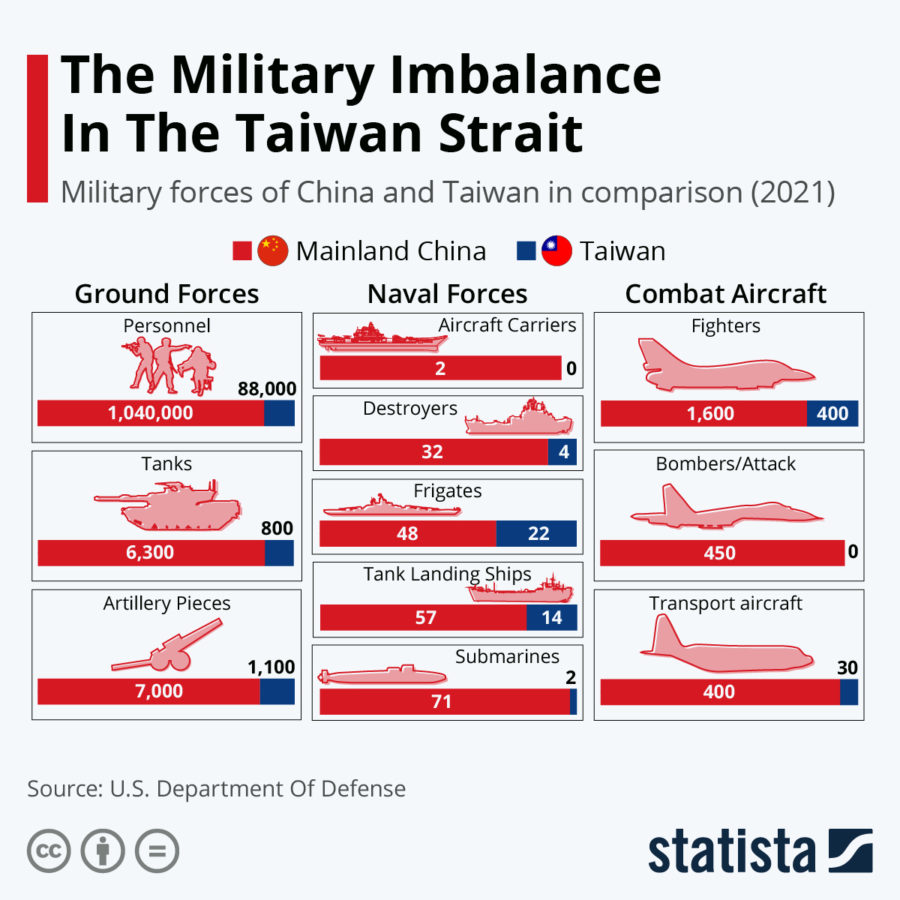
However, China, with its one-China policy, developed a social perception that Taiwan is a part of China and its reunification is significant. China constructed that the US maintains an unofficial connection with Taiwan and with Taiwan’s geopolitical importance the US continues to fuel the cross-strait relations.12
It identifies the US’ strategic ambiguity as an endeavor to strike a careful balance between aiding Taiwan and avoiding confrontation with China.13 When disparities in knowledge are acknowledged, they can lead to conflict as observed when China, the US, and Taiwan constructed different perceptions. International collaboration is an alternate method of dealing with contradictory knowledge, which usually leads to exploitation, as evident in the China-Taiwan dispute.
Conclusion
Taiwan’s national identity has evolved over time as a result of the Taiwanization and Sinicization processes. The clash between growing Taiwanese and traditional Chinese consciousness has heightened Taiwan Strait tensions thus jeopardizing East Asian stability. It is concluded that identities and perceptions play a major role in constructing social realities. The China-Taiwan conflict is a result of one such construction.
Endnotes
- Fu-Lai Tony Yu and Diana Sze Kwan, “Social Construction of National Identity: Taiwanese versus Chinese Consciousness,” Social Identities 14, no. 1 (2008): pp. 33-52, https://doi.org/10.1080/13504630701848515.
- Alexander Wendt, “Anarchy is what states make of it: The social construction of power politics,” International Organization, 46(2), 391, 1992.
- T.Y. Wang, “‘One China, One Taiwan’: An Analysis of the Democratic Progressive Party’s China Policy,” Taiwan in Perspective, January 2000, pp. 159-182, https://doi.org/10.1163/9789004473584_010.
- Ervin Goffman, The Presentation of Self in Everyday Life (Penguin Books: Harmondsworth, 1978).
- John F. Copper, “The Origins of Conflict across the Taiwan Strait: The Problem of Differences in Perceptions,” Journal of Contemporary China 6, no. 15 (1997): pp. 199-227.
- Alina Fayaz, Will Taiwan’s Conflict with China Lead to Reunification?, Paradigm Shift, October 18, 2021. https://www.paradigmshift.com.pk/taiwan-conflict-with-china/.
- Corcuff Stéphane, in Memories of the Future: National Identity Issues and the Search for a New Taiwan (London: Routledge, 2015).
- “The Evolution of a Taiwanese National Identity,” Wilson Center, accessed June 11, 2022, https://www.wilsoncenter.org/event/the-evolution-taiwanese-national-identity#:~:text=According%20to%20Dreyer%2C%20the%201979,on%20the%20island%2C%20Dreyer%20continued.
- Ibid.
- Lowell Dittmer, “Taiwan and the Issue of National Identity,” Asian Survey 44, no. 4 (2004): pp. 475-483.
- Richard Haass and David Sacks, “The Growing Danger of U.S. Ambiguity on Taiwan,” Foreign Affairs, June 8, 2022, https://www.foreignaffairs.com/articles/china/2021-12-13/growing-danger-us-ambiguity-taiwan.
- Clifford Geertz, The Integrative Revolution: Primordial Sentiments and Civil Politics in the New States (New York: The Free Press, 1963).
- Richard Haass and David Sacks, “The Growing Danger of U.S. Ambiguity,” Foreign Affair.
Bibliography
- Copper, John F. “The Origins of Conflict across the Taiwan Strait: The Problem of Differences in Perceptions.” Journal of Contemporary China 6, no. 15 (1997): 199–227.
- Corcuff Stéphane. Essay. In Memories of the Future: National Identity Issues and the Search for a New Taiwan. London: Routledge, 2015.
- Dittmer, Lowell. “Taiwan and the Issue of National Identity.” Asian Survey 44, no. 4 (2004): 475–83.
- “The Evolution of a Taiwanese National Identity.” Wilson Center. Accessed June 11, 2022.
- Fayaz, Alina. “Will Taiwan’s Conflict with China Lead to Reunification?” Paradigm Shift, December 29, 2021. https://www.paradigmshift.com.pk/taiwan-conflict-with-china/.
- Goffman, Ervin. The Presentation of Self in Everyday Life. Penguin Books: Harmondsworth, 1978.
- Haass, Richard, and David Sacks. “The Growing Danger of U.S. Ambiguity on Taiwan.” Foreign Affairs, June 8, 2022. https://www.foreignaffairs.com/articles/china/2021-12-13/growing-danger-us-ambiguity-taiwan.
- Wang, T.Y. “‘One China, One Taiwan’: An Analysis of the Democratic Progressive Party’s China Policy.” Taiwan in Perspective, 2000, 159–82.
- Wendt, Alexander. “Anarchy is what states make of it: The social construction of power politics.” International Organization, 46(2).
- Yu, Fu-Lai Tony, and Diana Sze Kwan. “Social Construction of National Identity: Taiwanese versus Chinese Consciousness.” Social Identities 14, no. 1 (2008): 33–52.
If you want to submit your articles, research papers, and book reviews, please check the Submissions page.
The views and opinions expressed in this article/paper are the author’s own and do not necessarily reflect the editorial position of Paradigm Shift.
